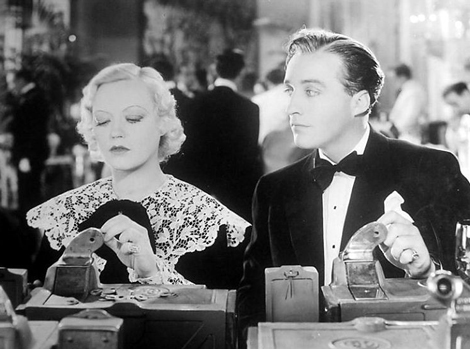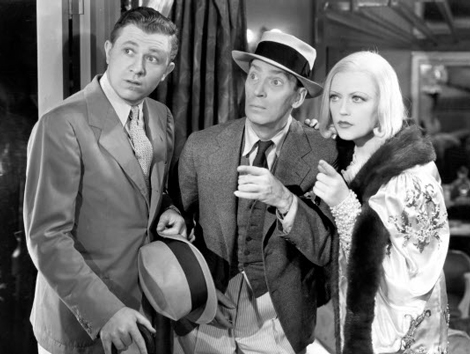Reviewed by Glenn Erickson
Elvis Presley and Rock 'n' Roll may have eclipsed the era of Bing Crosby, but the crooner dominated the radio airwaves for more than two decades. Crosby's singing voice was made for the new era of microphones, amplification and recording: instead of belting out his songs like Al Jolson or Ethel Merman, Crosby could murmur into the mike if he so chose, communicating a wider range of vocals.
As a movie personality Crosby first showed up in some short subjects and in an early talkie musical with bandleader Paul Whiteman; odd makeup choices and the 2-strip Technicolor process seemed to exaggerate his ears, making him look like a shaved monkey. That image awkwardness was straightened out by 1933 and Going Hollywood, an elaborate MGM musical actually produced by William Randolph Hearst's Cosmopolitan company.

Going Hollywood is a starring vehicle for Hearst's paramour Marion Davies, a talented comedienne unwisely promoted as a serious actress and glamorous clothes horse. Bing gets second billing but already shows more star appeal, even though the character he plays is a shallow cad. The movie is built around Crosby's songs, most of which are provided by the musical team of Arthur Freed and Nacio Herb Brown. Four of them are memorable winners, a good score for a 1932 non-Warners musical.
Major writing talent was involved. Donald Ogden Stewart did the screenplay from a story by celebrated scenarist Frances Marion. Just the same, the show's cure for a flimsy plot is to throw a lot of talent at the screen and see what sticks. Unhappy French teacher Sylvia Bruce (Marion Davies) exits the stuffy Briarcroft School after hearing crooner Bill Williams (Bing Crosby) on her radio; she pursues him as he travels West by rail to make a movie. When Bill doesn't respond to her advances, she takes a job as a maid to Bill's co-star Lili Yvonne (Fifi D'Orsay). But the two women become enemies when Sylvia discovers that Lili is Bill's lover as well. In Hollywood, new roommate Jill (Patsy Kelly) doesn't have to help Sylvia, as Bill's crabby director Conroy (Ned Sparks) takes one look at Sylvia's legs and gets the idea that she belongs in pictures. Investor-producer Ernest Baker (Stuart Erwin) tries to defuse Lili's on-set tantrums, to no avail; which sets up Sylvia to become the new leading lady. But Sylvia doesn't appreciate Bill's amorous advances, which cause misunderstandings that lead him to drink. How will this perfect Hollywood romance be resolved?
Bing Crosby looks great and sounds even better singing in Going Hollywood; this was before he dropped some of the jazzy trimmings and smoothed out his crooning. MGM's makeup job is still uneven -- the lipstick still looks a bit weird in some singing close-ups -- yet much of his later ultra-relaxed persona is already established. The screenplay gives Bing the chance to play drunk before reforming (with a song, of course) and these sequences show no great aptitude for drama. Bill Williams is a spoiled singing star with little tolerance for others, so it's the Crosby charm and voice that carry the day.
The nominal story is supposed to be about Marion Davies' Sylvia Bruce, whose actions surely served as a dismal role model for star-struck girls experiencing hormonal surges over their favorite radio crooners. The boarding school is intolerably rigid, so she escapes to follow her dream, which more or less means shadowing and harassing Bill Williams. The accurate word for this is stalking -- when she repeatedly shows up expecting Bill to sweep her off her feet, Sylvia shows no awareness beyond her own desires. Throwing one's self at a man's feet? That's fine. To justify Sylvia's amorous incursion Fifi D'Orsay's Lili is presented as an annoying French tomato with a bad wardrobe. She's a tramp, too, apparently sleeping with Bill. The film's director invites Sylvia into the production, and she immediately goes to work on Lili. Sylvia even precipitates a fight, which gives Lili a black eye and makes the substitution of a new star necessary.

Going Hollywood demonstrates clearly what the experts say about Marion Davies. When she's doing comedy bits or impressions, she's charming. As a serious dramatic artist, a dancer, and a fashion plate she's just so-so. Davies comes to life when she's being playful. Sylvia does an imitation of Lili's heavy French accent while singing. It's pretty cute. To sneak on the set Sylvia blacks her face and impersonates a plantation extra, and uses 'darkie' patois to insult Lili with a request for an autograph: "Please Miss Garbo?" The scene does not pass the racial sensitivity test.
But the show earns high marks for musical content. With Lennie Hayton conducting the orchestra we begin to get the feeling of MGM's later musical competence. For variety, the "Three Radio Rogues" do spoofs of current shows and personalities. One does an excellent imitation of Kate Smith singing When the Moon Comes Over the Mountain. We wonder, however, if these were friends of Bing Crosby, or perhaps an act he managed on the side.
The movie has two developed musical numbers. The signature tune Going Hollywood plays out in a train station, with agent Jack Thompson (Bobby Watson) trying to get Bill to show up, and director Conroy touting their new picture. Bill pops up atop a luggage cart to sing the key lyrics:
"Out where they say, Let us be gay I'm goin' Hollywood!"
The second is a 'rustic reverie' daydream in which Sylvia imagines the remote Bill taking her to a happy cottage in the country -- where a large field of flowers moves and tilts in unison to the music. It's a good stage effect. The song is the standard We'll Make Hay When the Sun Shines. Somewhere in there the number changes into a barnyard dance involving dancing scarecrows. (hmm 1) The barn roof says "Pink Pills" in large letters on its roof ... a reference to who knows what. Sylvia doesn't appear to be high on anything.

Several other songs simply show Crosby at the microphone, while the MGM optical department provides proto- music videos by splitting the screen, using trick lenses. The best of these songs is likely to be the well-known tune Beautiful Girl, later revived as a period piece in Singin' in the Rain. The images follow the lyrics when possible but the kaleidoscope treatment can't compete with the Busby Berkeley galas being done at Warners. MGM clearly decided to go with the star power. There are big sets and scenes with many dancers, but nothing that looks like it couldn't be staged with a couple of hours of preparation. 2
Perhaps the most amusing clip next to the title tune Going Hollywood is Crosby's brief number Temptation. Now relegated to major camp status, the song is suitable accompaniment for overheated seductions scenes, of the Rudolf Valentino sort. Great cornball stuff, the lyrics build on the notion that within every good girl is a tempting siren leading a good man astray. Drunken Bill sings it to Lili (seen in sultry close-up) in a Mexican bar after Sylvia has walked out on him:
"For you were born to be kissed / I can't resist your temptation... / And I am yours ! / Here is my heart !"
Crosby's baritone sells this with great emotion, no irony intended. Adapted as a tango, Temptation also saw comic use in Singin' in the Rain.
Director Raoul Walsh lends the show a flow and a polish. Sterling Holloway chases Bing around a room trying to record one song, and the scene has a nice 'we're making this up as it happens' feel. For one transition we see a Walsh signature shot of this time -- a black conductor steps up into a giant close-up to call out the departure of a train. Ned Sparks is his sour self, with little chance to vary the character. Fairly wasted is Stuart Erwin, who I associate with Paramount comedies. His meek, art-oriented producer has one bit where he gets to assert himself and take over the production, but the film doesn't resolve his art-film ideas or its own hints that he'll get together with the supporting comedienne played by Patsy Kelly. Kelly's sweet Jill has some okay lines but mostly holds Sylvia's hand. The three reasons for seeing Going Hollywood are Bing Crosby, the music and Marion Davies.

The Warner Archive Collection DVD-R of Going Hollywood is a fine transfer and encoding of this entertaining, just-clever-enough-not-to-be-a-fossil early musical. Should Crosby looks foolish at times, remember that he was by a wide margin the most popular singer of his day, and that he launched (and profited enormously from) numerous innovations in the broadcast and recording industries. He pioneered the tape-recording of radio shows, so that they wouldn't have to be re-performed to play in different time zones.
On a scale of Excellent, Good, Fair, and Poor,
Going Hollywood rates:
Movie: Very Good
Video: Excellent
Sound: Excellent
Audio: English
Supplements: none
Deaf and Hearing Impaired Friendly?
No; Subtitles: None
Packaging: Keep case
Reviewed: September 5, 2013
Footnotes:
1. As "Auntie Em" actress Clara Blandick is one of the biddies running the girl's school back at Briarwood, this show has a couple of Wizard of Oz associations.
Return
2. The 'Chinese' wardrobe design seen in the final musical number look awfully similar to outfits seen in the previous year's The Mask of Fu Manchu. This proves very little, as MGM must have had endless racks of instantly adaptable costumes of every description.
Return

DVD Savant Text © Copyright 2013 Glenn Erickson
See more exclusive reviews on the Savant Main Page.
Reviews on the Savant main site have additional credits information and are often updated and annotated with reader input and graphics.
Also, don't forget the
2011 Savant Wish List.
T'was Ever Thus.
Return to Top of Page
|

